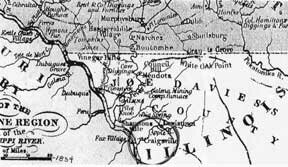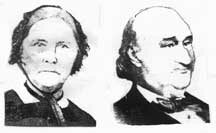
Discover rewarding casino experiences. 
Click on the Flag for More Information |
The following Spring Dan Fowler and Charles Ames returned, staked a claim and began farming. That a large Indian Village of Sac and Fox were there seemed no deterrent to their manipulation of the area. What was a drawback was that the region was part of the lead mine diggings and federal property, even though Wapello, its first identity and supposedly named for its Indian chief, was not in the mining district. This obstacle was to be corrected by strict attention to the problem by taking up a purse which ultimately amounted to $1,000 to send someone to Washington, D.C. to seek permission to remove parts of the territory from the mineral reserve so farms could be made and other businesses pursued; private, individuals development not just leases from the government. Not just anyone would be sent. "Someone" had to be convincing, commanding and knowledgeable and, of course, trustworthy. That someone was James Craig, then a resident of Galena who had come up in 1825 from St. Charles County, Missouri, the other lead region near the Mississippi Valley. To read the earliest history of Galena (which had also undergone many name changes) is to see that Craig was one of its movers and shakersa doer. His name is listed wherever there was something to be done. In 1827 he'd been appointed County Assessor but had to decline because of too many "business engagements," perhaps such as going to D.C. to lobby for a set-aside package? Or exploiting the Falls of the Apple River when he returned? And so forth. We note that by his being the representative for his neighbors in the mineral district that he was of fine character and also by having been singled out for assessor's office, honest and responsible. Not only was he appointed the city surveyor in 1836 but had also done the basic surveying of the hilly townsite ten years previous. He'd surveyed the Original Town and Principal Streets which remain almost the same today. Yes, James Craig served in many capacities such as miner, minister, miller, mill builder, besides that of surveyor. More than two dozen entries are found in the early history of Jo Daviess County/Galena and their founding. Having won permission for parts of the mineral district to be opened to private claims, not just federal supervision, (the U.S. Army was in charge) Craig and his son, Daniel, bargained with Fowler and Ames for half their "squatter's claim" and the water power of the Falls of Apple River. "Craig and Sons" dammed the Apple River at what till then was generally known as Wapello.
Legend has it that the reason the name was changed was because mail meant for Wapello, Iowa was too often misdirected to Wapello, Illinois and vice versa. Come now! Long before ZIP codes that is difficult to believe!! It locally, at least, became "Craigsville" due to the commanding presence of the new host at the trail crossing and the fact that he'd set about constructing both a saw mill and grist mill, the most needed trades in the wilderness day. "Illinois Place Names" lists Wapello as only one entry in a line of identities of post offices. Portsmouth, along the Mississippi, distributed the mail for the area for about six months (See PDQ Me 11/7-14-21, 1990 for Portsmouth history). The other settlements receiving/delivering mail from the Apple River site are listed, although there is no Craigsville, Jo Daviess, at all. It was merely a name to honor a local! When the land was freed up for private claims, numbers began streaming in for settling into farms and homes. James Craig brought his family down from Galena in 1829. The BlackHawk War interrupted settlement for a few months in 1832 and in which Craig served as a captain of mounted volunteers, the 27th Regiment, during that sorry conflict. He was also muster officer of the entire regiment. He was involved in many social and fraternal organizations also, including early on, the Strangers Union (Masonic) Lodge #14 plus serving two terms in the state legislature in 1836-1838. During his tenure at Springfield it was he who introduced the bill by which Carroll County was separated from Jo Daviess. The first order of business after organization of Carroll County was to pay $10.50 to James Craig for a copy of the law under which the county was organized (1834). Craig had prior connections with Carroll County other than the legal. It was he who built the first saw mill in what would become Carroll, that at what was known as the Bowen Mill site on Plum River at the east edge of Savanna, the site now of Old Mill Park. James Craig wore many hats and was tireless in the forwarding of the progress of all of the Northwest. By 1835 he'd built a chair factory, too, beside the saw-grist mill and according to him, "The water power was sufficient to drive the three establishments." That year also his son, William, opened the first general store at Craigsville. There was no other, it's believed, until 1845 when James White arrived. His short resume was printed in last week's column. White had come to the Falls in 1845 from Savanna where he'd been an inventive merchant and had married a local girl, Almira Jenks. He'd bought the water power from Craig which factories had stood idle for nearly three years due to a fire leveling the mills. Craig, the miller, had torn down the first rudimentary mill and in 1840, constructed a fine, more modern one with two stories of stone and two and a half of wood. Reference states that building such a mill was slow and costly so it was not completed until 1842. It had operated but six weeks when it burned to the ground. James Craig had heavily invested in that construction and could not then afford to rebuild ... "It proved a misfortune not only to the founder of the village but the town itself," history relates. As recently given, James White purchased the mill site three years later and built a new dam, saw mill and flouring mill. Later the saw mill was removed largely because commercial-cut lumber was reaching the market. The White flouring mill was four and a half stories tall in stone with five run of buhrs. In 1857 a rear wall collapsed and all other walls were removed. It was reconstructed with only three levels. The picture with the April 1st issue is but one example of the awesome heights in which such factories were built at early times, a feat of some accomplishment. That picture was supplied by the Hanover Township Library with our thanks for it and the assistance given of Hanover history which is unique in that it was an "industrial complex" long before those words were even "invented!!!" The Craig family pictures derive from Frank Stevens' book, The BlackHawk War. Wheat which had been the major local crop for some years began to fail in the late 1850s-early '60s. One reference states that the "cinch bug played havoc with the wheat" so the mill was shut down. White was advised by Galena capitalists to try the manufacture of woolen goods cassimeres as noted last week. A mechanical loom was "harnessed to the river" resulting in an eight decades long industry keeping the old, old town humming with a different pulse. Believing in his product and the local work force, White was said to have peddled the woolen goods door-to-door by peddler's wagon. The paper pulp mill begun in 1875 by James White was another job source for that area. If it wasn't White believing in the community's ability to supply the energy, it had been James Craig before him. White lived until 1909 and was buried in the hilltop Evergreen Cemetery. It had been he who'd believed, apparently, that the site should have a more "official" title than Craigsville or Wapello which hadn't "caught on" with the postal department, we guess. He proposed Hanover for a town in his native state of New Hampshire. One source says that an act of the legislature in 1849 gave it its present titleHanover. Perhaps, James Craig's fortunes never did accumulate after the disastrous mill fire of 1842. It's said that he'd always kept a "public house" since his arrival in the late 1820s, meaning rooms and food for travelers, doubtless, abetted by his estimable wife, Delinda Boone Craig who was noted also for her knowledge of medicines and healing. She is prominently mentioned in nearly every entry of her husband's accomplishments because of her worthiness and her ancestry. She was the granddaughter of our American hero, Daniel Boone. Delinda Craig lived until 1877 and with most of their family (of seven) is buried in Evergreen Cemetery where whispers of the past can tell many tales more interesting than fiction. James Craig had died in 1847 at age sixty-five. He'd fallen into a lead mine hole near Elizabeth which accident led to his death. Ironic, perhaps, that the end for him was an immediate part of his life. He was a frontiersman to remember and a founder to be admired.
|





